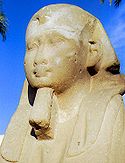
Nectanebo I
Encyclopedia
Nectanabo was a pharaoh
of the Thirtieth dynasty of Egypt
.
In 380 BC, Nectanebo deposed and killed Nefaarud II
, starting the last dynasty of Egypt
ian kings. He seems to have spent much of his reign defending his kingdom from Persian
reconquest with the occasional help of troops from Athens
or Sparta
. He is also known as a great builder who erected many monuments and temples
He is also known as a great builder who erected many monuments and temples
throughout his long and stable 18-year reign. Nectanebo I restored numerous dilapidated temples throughout Egypt and erected a small kiosk
on the sacred island of Philae
which would become one of the most important religious sites in Ancient Egypt. This was the first phase of the temple of Isis at Philae; he also built at Elkab, Memphis and the Delta sites of Saft el-Hinna and Tanis. He also significantly erected a stela before a pylon of Ramesses II
at Hermopolis
. He also built the first pylon in the temple of Karnak. From about 365 BC, Nectanebo was a co-regent with his son Teos
, who succeeded him. He died in 362 BC and was succeeded by Teos on the throne.
Pharaoh
Pharaoh is a title used in many modern discussions of the ancient Egyptian rulers of all periods. The title originates in the term "pr-aa" which means "great house" and describes the royal palace...
of the Thirtieth dynasty of Egypt
Thirtieth dynasty of Egypt
The Thirtieth Dynasty of ancient Egypt followed Nectanebo I's deposition of Nefaarud II, the son of Hakor. This dynasty is often considered part of the Late Period....
.
In 380 BC, Nectanebo deposed and killed Nefaarud II
Nefaarud II
Nepherities II or Nefaarud II became Pharaoh of Egypt in 380 BC after the death of his father Hakor. He was the last pharaoh of the twenty-ninth dynasty and the son of Hakor. He was deposed and likely killed by Nectanebo I after ruling Egypt for only 4 months.-References:...
, starting the last dynasty of Egypt
Egypt
Egypt , officially the Arab Republic of Egypt, Arabic: , is a country mainly in North Africa, with the Sinai Peninsula forming a land bridge in Southwest Asia. Egypt is thus a transcontinental country, and a major power in Africa, the Mediterranean Basin, the Middle East and the Muslim world...
ian kings. He seems to have spent much of his reign defending his kingdom from Persian
Achaemenid Empire
The Achaemenid Empire , sometimes known as First Persian Empire and/or Persian Empire, was founded in the 6th century BCE by Cyrus the Great who overthrew the Median confederation...
reconquest with the occasional help of troops from Athens
Athens
Athens , is the capital and largest city of Greece. Athens dominates the Attica region and is one of the world's oldest cities, as its recorded history spans around 3,400 years. Classical Athens was a powerful city-state...
or Sparta
Sparta
Sparta or Lacedaemon, was a prominent city-state in ancient Greece, situated on the banks of the River Eurotas in Laconia, in south-eastern Peloponnese. It emerged as a political entity around the 10th century BC, when the invading Dorians subjugated the local, non-Dorian population. From c...
.

Egyptian temple
Egyptian temples were built for the official worship of the gods and commemoration of pharaohs in Ancient Egypt and in regions under Egyptian control. These temples were seen as houses for the gods or kings to whom they were dedicated...
throughout his long and stable 18-year reign. Nectanebo I restored numerous dilapidated temples throughout Egypt and erected a small kiosk
Kiosk
Kiosk is a small, separated garden pavilion open on some or all sides. Kiosks were common in Persia, India, Pakistan, and in the Ottoman Empire from the 13th century onward...
on the sacred island of Philae
Philae
Philae is an island in the Nile River and the previous site of an Ancient Egyptian temple complex in southern Egypt...
which would become one of the most important religious sites in Ancient Egypt. This was the first phase of the temple of Isis at Philae; he also built at Elkab, Memphis and the Delta sites of Saft el-Hinna and Tanis. He also significantly erected a stela before a pylon of Ramesses II
Ramesses II
Ramesses II , referred to as Ramesses the Great, was the third Egyptian pharaoh of the Nineteenth dynasty. He is often regarded as the greatest, most celebrated, and most powerful pharaoh of the Egyptian Empire...
at Hermopolis
Hermopolis
Hermopolis Magna or simply Hermopolis or Hermopolis Megale or Hermupolis is the site of ancient Khmun, and is located near the modern Egyptian town of El Ashmunein in Al Minya governorate.-Etymology:Khmun, the Ancient Egyptian name of the city, means "eight-town", after the Ogdoad, a group of...
. He also built the first pylon in the temple of Karnak. From about 365 BC, Nectanebo was a co-regent with his son Teos
Teos of Egypt
Teos or Tachos , Egyptian Djedhor, was Pharaoh of Egypt between the years of 362 to 360 BC; he had been co-regent with his father Nectanebo I from about 365. He was overthrown by Nectanebo II with the aid of Agesilaus II of Sparta and was forced to flee to Persia by way of Arabia...
, who succeeded him. He died in 362 BC and was succeeded by Teos on the throne.

